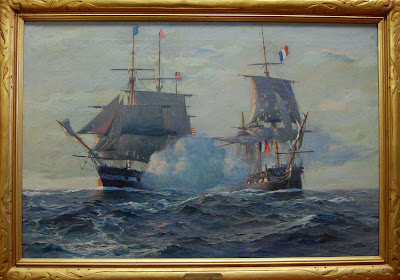Live War Game Demonstration: Introduction to Memoir '44
Tonight is game night for the Naval War College Museum and Puget Sound Navy Museum! Our live war game demonstration will be streamed live to the NWCM Facebook page starting at 7:00 PM EST, and we look forward to seeing you there.
For those of you who are new to war gaming, we’d like to offer a quick preview of the game we’ll be playing called Memoir ‘44. It simulates WWII land battles at the platoon, company, and battalion levels. The rules are fairly simple (though more complex than popular boardgames like Risk) and can be downloaded at the following link if you would like to learn how to play:
If you would rather not spend time reading rules, a quick summary should suffice. The game is played using cards that activate certain units on the map. Players never get to move all their pieces at once but must manage their cards to move different units at different times in order to maximize their side’s advantages. The map is divided into left, center, and right sections with most cards allowing you to move a certain number of units in one section. Other cards allow for moving units of one type such as infantry or armor.
Units roll dice to determine their success in combat. The dice are not standard numerical dice, but instead have unit symbols that match the playing pieces. If you roll a symbol that represents the unit type you are targeting, that unit takes 1 hit. Units generally get to roll more dice the closer they are to their target. Infantry are very powerful when attacking from an adjacent hex which represents the use of grenades and close assault tactics. Tanks and artillery can fire at greater ranges than infantry but are vulnerable to attack by infantry if they can get close enough.
 |
| click to enlarge |
The scenario we’ll be playing is from the Battle of Okinawa and features the 6th Marine Division attacking the western end of the Shuri Line during the third week of May, 42 days after the initial beach landings. The Japanese troops defending this position are from the 32nd Army and occupy a string of dug-in positions atop two key terrain features, Sugar Loaf Hill and Half Moon hill (also known as Crescent Hill). The screenshot above shows the opening setup with the Marines approaching from the bottom of the board.
The Japanese have the advantage of terrain. In the real battle, they spent months before the invasion digging an extensive system of tunnels and caves that connected Sugar Loaf and Half Moon. In the game, Japanese units in caves reduce the number of dice the attacker rolls. They also have the special ability to move instantly from one cave to any other cave on the board.
 |
| click to enlarge |
You will also notice special symbols on a few of the Marine units. The shield with the castle indicates a combat engineer. These units are specially trained in clearing obstacles and fighting in difficult terrain. They do not have their combat dice reduced when attacking a unit in a cave. They can also seal the entrance to the cave and prevent other enemy units from using it. The artillery unit that has a shield above it is mobile artillery. Normal artillery units must either move or shoot when it is their turn. Mobile artillery can move AND shoot as long as they only move one hex.
 |
| click to enlarge |
As you watch the game unfold tomorrow night, please post your comments, ask questions, suggest possible moves, and root for your favorite museum to win! Can’t wait to see you online!
Rob Doane
Curator
Naval War College Museum


Comments
Post a Comment